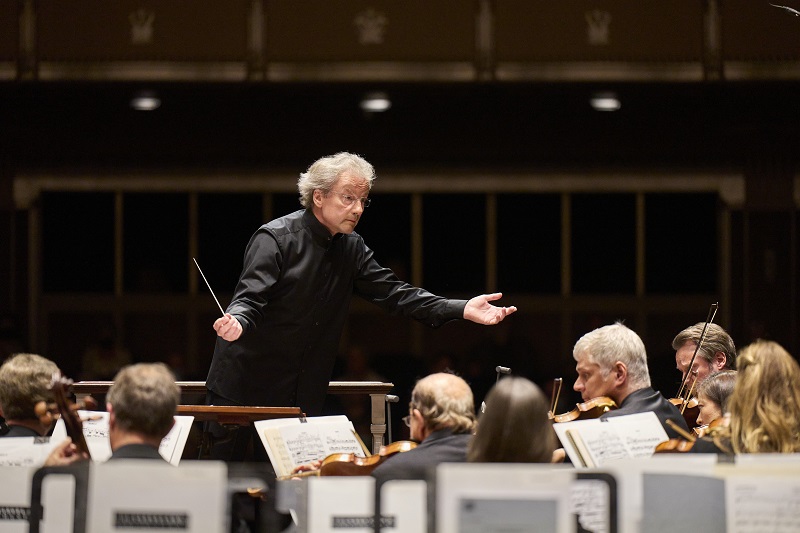 United States Berg, Rihm, Schubert: Cleveland Orchestra / Franz Welser-Möst (conductor). Mandel Concert Hall at Severance Music Center, Cleveland, 12.5.2022. (MSJ)
United States Berg, Rihm, Schubert: Cleveland Orchestra / Franz Welser-Möst (conductor). Mandel Concert Hall at Severance Music Center, Cleveland, 12.5.2022. (MSJ)

Berg – Three Pieces from Lyric Suite
Rihm – Verwandlung II
Schubert – Symphony No.9 in C major, D.944, ‘Great’
The week in March 2020 that the Covid pandemic performance ban was enacted in Ohio, Franz Welser-Möst and the Cleveland Orchestra were rehearsing Schubert’s ‘Great’ Ninth Symphony. With performance forbidden, the ensemble, very mindful of the value of music, went ahead and recorded the piece and released it on their in-house label. Finally, with the bulk of the pandemic horror behind us, they were able to present the work live to a grateful audience. It was a performance for the ages.
As I detailed in my review (here) of the TCO release at MusicWeb International, the Great C major has a long history of exaggerations and distortions that have done it no favors. Some conduct it like it is Beethoven, some like it is Bruckner. Remarkably few conductors have unlocked the simple radiance of the score but, as this performance again proved, Welser-Möst belongs to the pantheon of insightful Schubertians.
Most conductors create a problem for themselves right off the bat by taking the first movement introduction at a glacial pace, despite Schubert’s clear ‘Andante’ marking (as opposed to a slow speed such as Adagio or Largo). This exaggeration in turn forces conductors to do a ridiculous acceleration into the main Allegro. The Cleveland Orchestra performance proved that by taking a flowing tempo at the beginning, with emphasis on phrases instead of bar lines, the music builds quite naturally, with a slight acceleration, into the Allegro.
Likewise, at the end of the movement, conductors often slow down the return of the introduction’s theme to match their previous speed, even though the score hints at no such thing. Welser-Möst rightly does the passage thrillingly in tempo. Again, the emphasis on long phrases instead of punching every rhythmic unit makes it work superbly.
In the (somewhat) slow movement, the performance was buoyed by the radiant and characterful playing of the best woodwind section this side of anywhere, building up to a harrowing panic in the middle of the movement. The Scherzo was a masterpiece of Viennese charm, some phrases leaned into, others given with just the right hesitation. It is no coincidence that Welser-Möst will be conducting the Vienna Philharmonic’s New Year’s Day concert for the third time in 2023. He knows how to bring Austrian music off the page and dancing into the imagination.
The Finale was delightful, less hurried than most and gaining in poise, grace and power by not being rushed off its feet. It gave the movement the weight to properly counterbalance the first movement, and allowed for hushed transitions that could raise goose-bumps. The audience response was little short of ecstatic.
An interesting link in lyricism was demonstrated by opening the concert with Alban Berg’s arrangement of three movements from his Lyric Suite. Originally for string quartet, Berg selected three of the six movements and arranged them for full string orchestra, creating a lovely quasi-symphony. While the music makes use of serialism and non-tonal elements, it can be bewitchingly lovely when it is played like it was in this performance. The Cleveland strings gave tremendous care to the shape of phrases, finding an intimate singing quality that includes refinement but doesn’t ever turn it into a fetish. A quick review of older recordings of the work shows just how much ensembles used to struggle with this music. Welser-Möst and the Clevelanders kept it tenderly human.
Between the Berg and Schubert came the local premiere of Wolfgang Rihm’s Verwandlung II. There is no doubt that Rihm sees himself as a modern successor to Schubert via Mahler and Strauss, and his fluent use of modern processes legitimizes the transformations of the title. It did strike me on this first hearing, however, as a work of dazzling moments that didn’t necessarily cohere as a whole no matter how brilliant the parts. Perhaps further acquaintance would better reveal its qualities. Rihm has proven before that he is a composer of great imagination with a sensitive ear for textures, so it is always worth hearing his thoughts. The performance was impressive, with imposing sonorities in the brass and arresting details in the percussion.
All that remains in Franz Welser-Möst’s twentieth season with the Cleveland Orchestra is the closing Otello festival, which will include performances of Verdi’s opera and orchestral programs inspired by it.
Mark Sebastian Jordan
